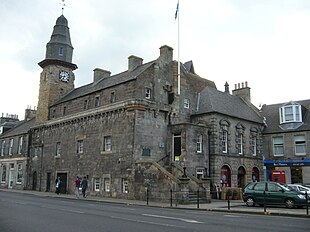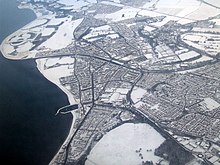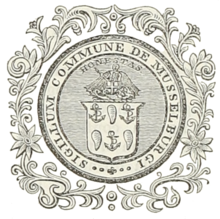Musselburgh
Musselburgh
| |
|---|---|
 Rennie Bridge over the River Esk | |
Location withinEast Lothian Location near theCity of Edinburgh council area | |
| Population | 21,100 (2022)[2] |
| •Edinburgh | 5 mi (8 km) |
| •London | 329 mi (529 km) |
| Civil parish |
|
| Council area | |
| Lieutenancy area | |
| Country | Scotland |
| Sovereign state | United Kingdom |
| Post town | MUSSELBURGH |
| Postcode district | EH21 |
| Dialling code | 0131 |
| Police | Scotland |
| Fire | Scottish |
| Ambulance | Scottish |
| UK Parliament | |
| Scottish Parliament | |

Musselburgh(/ˈmʌsəlbərə/;Scots:Musselburrae;Scottish Gaelic:Baile nam Feusgan)[3]is the largest settlement inEast Lothian,Scotland,on the coast of theFirth of Forth,five miles (eight kilometres) east ofEdinburghcity centre. It has a population of 21,100.
History
[edit]The name Musselburgh isOld Englishin origin, withmusselreferring tothe shellfish.[note 1]Theburghelement appears to derive fromburh,in the same way as Edinburgh, before the introduction of formal burghs byDavid I.[4]Its earliest Anglic name wasEskmuthe(Eskmouth) for its location at the mouth of theRiver Esk.
Musselburgh was first settled by theRomansin the years following their invasion of Scotland in 80 CE. They built aforta little inland from the mouth of the River Esk, atInveresk.
They bridged the Esk downstream from the fort, and thus established the line of the main eastern approach to Scotland's capital for most of the next 2,000 years. The bridge built by the Romans outlasted them by many centuries. It was rebuilt on the original Roman foundations some time before 1300, and in 1597 it was rebuilt again, this time with a third arch added on the east side of the river. The Old Bridge is also known as the Roman Bridge and remains in use today by pedestrians. To its north is the New Bridge, designed byJohn Rennie the Elderand built in 1806. This in turn was considerably widened in 1925.
Musselburgh was made aburghof barony c.1315 and a burgh of regality in 1562. The town attempted to become aroyal burghin 1632 but this was prevented by opposition from Edinburgh burgesses. Although Edinburgh is now known to have been a burgh by 1125, Musselburgh's antiquity is reflected in theScots-languagetraditional rhyme:
Musselburgh was a burgh
When Edinburgh was nane,
And Musselburgh will be a burgh
When Edinburgh's gane.[5]

Musselburgh is known as "The Honest Toun", and celebrates this by the annual election of the Honest Lad and Lass. The town motto "Honestas"dates back to 1332, when the Regent of Scotland,Randolph, Earl of Moray,died in the burgh after a long illness during which he was devotedly cared for by the townsfolk. His successor offered to reward the people for their loyalty but they declined, saying they were only doing their duty. The new regent, theEarl of Mar,was impressed and said they were a set of honest men, hence "Honest Toun".
Archaeological excavations byHeadland Archaeologybetween 2003–04, as part of work to renew the water mains, found that the Medieval town was concentrated on the High Street and that occupation in the North High Street area and Fisherrow only dates to the 16th century or later. The early town was centred on the eastern side of the river Esk.[6]
Stoneyhill House dates from the mid 18th century. The estate of Stoneyhill was formerly owned bySir William Sharpand later passed to theEarl of Wemyss.[7]
The town and its population grew considerably throughout the latter half of the twentieth century, with major local authority and private housing developments on both the eastern and western outskirts.
TheBattle of Pinkie,part of theRough Wooingbetween Scotland and England, was fought south of Musselburgh in 1547.
Town Council
[edit]Prior to thelocal government reforms of 1975,Musselburgh was asmall burghwithin the county of Midlothian. As such, it elected a town council responsible for a number of areas of local governance, including housing, lighting and street cleaning and drainage. Midlothian County Council was responsible for other areas, including education. The town council met at theMusselburgh Tolboothand later, for a short period before its abolition, at the Brunton Hall. The town's civic head and chairman of the council was theprovostand there were threebailiesand a treasurer.[8]
| Provost[9] | Party | Term | |
|---|---|---|---|
| David Lowe | Independent | 1928-37 | |
| John Henry Paton | Independent | 1937-40 | |
| Thomas White | Labour | 1940-45 | |
| Daniel Feeney | Labour | 1946-49 | |
| Robert Hunter | Labour | 1949-56 | |
| Joseph H. F. Reid | Moderate | 1956-57 | |
| James Lannan | Labour | 1957-60 | |
| Peter Hamilton | Labour | 1960-63 | |
| Robert Arthur | Labour | 1963-66 | |
| Thomas White | Labour | 1966-69 | |
| William Caird | Ratepayers | 1969-72 | |
| Jessie B. Burns | Labour | 1972-75 | |
After the local government reforms of 1975, Musselburgh was transferred to the East Lothian district of the new Lothian region, and subsequently became part of the East Lothianunitary councilarea in 1996.[10]
Demography
[edit]Population
[edit]At the 2022 census, the population was 21,479 and 79.2% of residents were born in Scotland, 9.5% other UK, 7.2% Europe and 4.1% Other.
| Ethnicity | Musselburgh | Scotland[11] |
|---|---|---|
| White | 95.2% | 92.9% |
| Asian | 2.2% | 3.9% |
| Black | 0.6% | 1.2% |
| Mixed | 0.7% | 1.1% |
| Other | 1.3% | 0.9% |
Religion
[edit]At the2011 Census,52% of Musselburgh residents stated they belonged to a religion, with 51% being Christians,[12]and there are several churches catering to different denominations.
| Religion | Number | % |
|---|---|---|
| Christian (total) | 7,352 | 36.4% |
| No religion | 12,243 | 60.6% |
| Church of Scotland | 3,976 | 19.7% |
| Roman Catholic | 2,221 | 11.0% |
| Religion not stated | 1,237 | 11.5% |
| Other Christian | 1,155 | 5.7% |
| Muslim | 237 | 1.2% |
| Other religion | 380 | 1.9% |
Church of Scotland
[edit]There are threeChurch of Scotlandecclesiastical parishes in Musselburgh, each with its own church, however discussions are currently underway regarding the future of these three churches and possible amalgamation:[13]
- North Esk
- St. Andrew's High
- St. Michael's, Inveresk
Roman Catholicism
[edit]There is oneRoman Catholiccongregation which worships at Our Lady of Loretto and St Michael Catholic Church.
Scottish Episcopal Church
[edit]There is oneScottish Episcopalcongregation which worships at St Peter's Church.
Other Churches
[edit]- Harbour Church
- Hope Church
- Musselburgh Baptist Church
- Musselburgh Congregational Church
Education
[edit]Schools includeLoretto School,a privateboarding school,andMusselburgh Grammar School,the local largecomprehensivethat is one of the oldestgrammar schoolsin the country, dating from 1608. Primary schools include: Campie Primary School, Musselburgh Burgh Primary School, Stoneyhill Primary School, Pinkie St Peter's Primary School, Loretto RC Primary School and Loretto Nippers (private). Early learning locations (ages 3–5) include The Burgh, Stoneyhill, Loretto RC, and St. Ninian's. There are also several private nurseries for pre school aged children.
Edinburgh'sQueen Margaret Universityhas relocated all its schools from Edinburgh to Musselburgh as of 2007[update].Her Majesty The Queenofficially opened the QMUcampusin July 2008.
Transport
[edit]

Railway
[edit]Musselburgh is served by two railway stations.Musselburgh railway stationis in the west of the town adjacent to Queen Margaret University and has regularScotRailservices fromEdinburgh WaverleytoNorth Berwick.It is a relatively new station, having opened in 1988. The other station serving the town isWallyford railway stationto the east of the town in the village ofWallyford,which opened in 1994.
The town'soriginal stationwas close to the town centre at the end of a short branch from Newhailes Junction. Passenger services from there ceased in 1964, and the line closed to all traffic in the early 1970s. The former railway line is now a road bypassing theFisherrowarea of the town. There was alsoa stationat Fisherrow.
Bus
[edit]The town is served byLothian Buses,East Coast Busesand Prentice Coaches Ltd.[14]
Roads
[edit]TheA1by-passes the town and meets theA720 Edinburgh City Bypassat the edge of the town before continuing to Edinburgh city centre. The A199 goes through the High Street toEdinburghin the west and toDunbarto the east. This was originally theA1until the town's bypass was built in the mid-1980s.
Sport
[edit]The Musselburgh Silver Arrow is reputed to be the oldest sporting trophy in United Kingdom,[15]and is competed for annually by theRoyal Company of Archers.It dates back to at least 1603.[16]
Musselburgh is home to bothMusselburgh RacecourseandMusselburgh Linksgolf course. The links, a former venue ofgolf'sOpen Championship,have recently been acknowledged as the oldest continuously played golf course in the world.[17]Musselburgh Athletic F.C.are the town's football team, competing in theEast of Scotland Leagueat their Olivebank Park ground in the west of the town. Musselburgh also boast some of the best grassroots teams for young players, such as the Musselburgh Windsor and the Musselburgh Youngstars.Musselburgh RFCplay in theScottish Premiershipat Stoneyhill.
The Musselburgh Roads Cycling Club was formed in January 1936 by a breakaway group of 16 from the Musselburgh Clarion. After forming an alliance with other clubs during the war, the MRCC reformed again in its own right in January 1945. The club has a long and successful history of competitive cycling. Notable riders include: Jock Allison, who in 1945 won theBritish Best All Roundertitle and is to date still the only Scottish club rider to do so; Janet Sutherland, who dominated Scottish woman's cycling in 1951–4; and Sandy Gilchrist, who in 1977 won 5 individual and 4 team Scottish Championships. Many other riders from the club have won national championships or have been selected to compete at world championship level or theCommonwealth Games.Today, club members take part in track racing, road racing, time trials, cyclo cross and mountain biking. Their base is at the Tolbooth in the High Street.
There is also a locally rundartsleague, the Musselburgh and District Darts League, comprising an A and B league, each containing eight teams. Many players from this league represent the Lothian team at county level.
In Musselburgh there is also an amateur swimming club called Musselburgh Amateur Swimming Club. The club is home to the Musselburgh Marlins and trains at Musselburgh Sports Centre. The members of the club vary in ages from 6 all the way up to adults. The club is very inclusive in the community and was first established in 1886 and in its current format in 1994 where they trained at Loretto Swimming Pool which is now closed.
The East Lothian Seagulls of the ScottishFloorballLeague are based in Musselburgh and train and play matches at the sports centre at Queen Margaret University.
Notable people
[edit]

- Acting
- James Martin,best known for his role as Eric inStill Game.Although originally from Glasgow, he has lived in East Lothian since 1974.
- Callum Kerr,actor and musician
- David Macbeth Moir,physician and writer
- Military
- John Grieve,recipient of theVictoria Cross
- Writers and artists
- Alexander Carrick,sculptor
- Margaret Oliphant,novelist and historical writer, who usually wrote as Mrs Oliphant
- Sports
- Gary Anderson,darts player
- Alistair Brown, footballer
- Billy Brown,football coach
- John Clark,footballer
- Jason Holt,footballer
- Willie Jamieson,footballer
- Jim Jefferies,football manager
- John McGlynn,football manager
- Michael McKenna,footballer
- Paul McLean,footballer
- Bill McPhillips,footballer
- Kenny Miller,footballer
- Alan Morgan,footballer
- Ross Muir,professional snooker player
- Scott Murray,rugby union player
- Yvonne Murray,athlete
- Colin Nish,footballer
- Willie Ormond,footballer and manager
- Kirsten Reilly,footballer
- Kris Renton,footballer
- George Walker,footballer
- John White,footballer
- Various
- Callum Beattie,singer-songwriter
- Rhona Cameron,comedian
- Kirsten Imrie,professional model and formerPage Threegirl
Areas
[edit]Fisherrow,Inveresk,Levenhall Links,Pinkie,Stoneyhill, Clayknowes, Denholm, Stoneybank,Queen Margaret UniversityStudent Village, Monktonhall, Pinkie Braes
Twin towns
[edit]Musselburgh is twinned with:[20]
- Champigny-sur-Marne(France)
- Rosignano Marittimo(Italy)
"Champigny was already twinned with Rosignano, so a three-way link was considered advantageous."[20]
Gallery
[edit]-
A panoramic view of Fisherrow harbour and its pleasure craft
-
Harbour Master's Office at Fisherrow
-
Pinkie House,now one of the buildings of Loretto School
-
Scottish Episcopal church on the High Street
-
Eskmills, a former factory complex, is transformed into a business park
-
Musselburgh railway station, showing a local eastbound (North Berwick) train, and a westbound (Edinburgh) intercity (125) train
-
Brunton Hall provides access toEast Lothian Council's services, as well as a theatre and restaurant
-
Brunton Hall, from the west of the town
See also
[edit]References
[edit]Notes
[edit]- ^Musselburgh was famous for the mussel beds which grew in the Firth of Forth; after many years of claims that the mussels were unsafe for consumption, a movement has been started to reestablish the mussel beds as a commercial venture.
Citations
[edit]- ^"Map of Scotland in Scots - Guide and gazetteer"(PDF).
- ^"Mid-2020 Population Estimates for Settlements and Localities in Scotland".National Records of Scotland.31 March 2022.Retrieved31 March2022.
- ^"Musseburgh".National Place-Names Gazetteer.Ainmean-Àite na h-Alba.Archived fromthe originalon 25 April 2012.Retrieved22 October2011.
- ^"The early history of Scotland and meanings of the clan names and place-names appearing on the Clan Map of Scotland".gwp.enta.net.Archived fromthe originalon 17 May 2006.
- ^Ayton, John; Crofton, Ian (2005).Brewer's Britain & Ireland.Weidenfeld and Nicolson.p. 787.
- ^"Vol 30 (2009): Archaeological monitoring in the streets of Musselburgh: recent discoveries | Scottish Archaeological Internet Reports".journals.socantscot.org.Retrieved12 August2021.
- ^"Stonehouse - Stromness Pages 500-519 A Topographical Dictionary of Scotland".British History Online.S Lewis, London 1846.Retrieved7 April2023.
- ^"Scran Web Site".Scran.Retrieved13 July2021.
- ^"Scran Web Site".Scran.Retrieved13 July2021.
- ^See alsoLocal Government etc. (Scotland) Act 1994,Office of Public Sector Information (OPSI) websiteArchived1 March 2010 at theWayback Machine(OPSI home pageArchived18 April 2008 at theWayback Machine)
- ^ab"Musselburgh (United Kingdom)".citypopulation.de.Retrieved16 August2024.
- ^"Scotland's Census 2011 (Table KS209SCb - Religion)".
- ^Church of Scotland Statistics for Mission Group
- ^"Timetables - Prentice of Haddington".prenticeofhaddington.info.
- ^Hugo Arnot,The History of Edinburgh, from the earliest accounts, to the year 1780,Edinburgh, 1816
- ^"Musselburgh".Archived fromthe originalon 6 October 2006.
- ^"Links play out onto record books".BBC News.co.uk. 17 March 2009.Retrieved18 March2009.
- ^Groome 1895,p. 88.
- ^Lewis 1846,p. 294.
- ^ab"East Lothian Council: Town Twinning".Retrieved14 April2020.
Sources
[edit]- Carlyle, Alexander (1791)."Parish of Inveresk".The statistical account of Scotland. Drawn up from the communications of the ministers of the different parishes.Vol. 16. Edinburgh: W. Creech. pp. 1–19.Retrieved1 July2020.
- Chisholm, Hugh,ed. (1911). "Musselburgh".Encyclopædia Britannica.Vol. 19 (11th ed.). Cambridge University Press.
- Groome, Francis, Hindes (1882). "Inveresk".Ordnance gazetteer of Scotland: a survey of Scottish topography, statistical, biographical, and historical.Vol. 2. Edinburgh: T.C. Jack. pp.296-297.Retrieved6 June2020.
{{cite book}}:CS1 maint: multiple names: authors list (link) - Groome, Francis, Hindes (1895)."Musselburgh".Ordnance gazetteer of Scotland: a survey of Scottish topography, statistical, biographical, and historical.Vol. 5. Edinburgh: T.C. Jack. pp.85-89.Retrieved6 June2020.
{{cite book}}:CS1 maint: multiple names: authors list (link) - Hannah, Ian Campbell (1913)."Eskdale".The Berwick and Lothian coasts.London: T.F. Unwin. pp. 179–200.Retrieved1 July2020.
- Lewis, Samuel (1851)."Inveresk".A topographical dictionary of Scotland, comprising the several counties, islands, cities, burgh and market towns, parishes, and principal villages, with historical and statistical descriptions: embellished with engravings of the seals and arms of the different burghs and universities.Vol. 1. London: S. Lewis and co. pp.586-587.Retrieved6 June2020.
- Lewis, Samuel (1846)."Musselburgh".A topographical dictionary of Scotland, comprising the several counties, islands, cities, burgh and market towns, parishes, and principal villages, with historical and statistical descriptions: embellished with engravings of the seals and arms of the different burghs and universities.Vol. 2. London: S. Lewis and co. pp.294-296.Retrieved6 June2020.
- Moodie, Leslie; Beveridge, J. G. (1845)."Parish of Inveresk".The new statistical account of Scotland. [electronic resource].Edinburgh and London: William Blackwood and Sons. pp. 246–304.Retrieved1 July2020.
- Paterson, James (1857).History of the Regality of Musselburgh: with numerous extracts from the town records.Musselburgh: J. Gordon. pp. 1–253.Retrieved1 July2020.
- Scott, Hew (1915).Fasti ecclesiae scoticanae; the succession of ministers in the Church of Scotland from the reformation.Vol. 1. Edinburgh: Oliver and Boyd. pp.324–328.Retrieved27 February2019.
External links
[edit] Musselburghtravel guide from Wikivoyage
Musselburghtravel guide from Wikivoyage- Census data (PDF)
- Musselburgh Festival
- Video footage of Fisherrow Harbour








